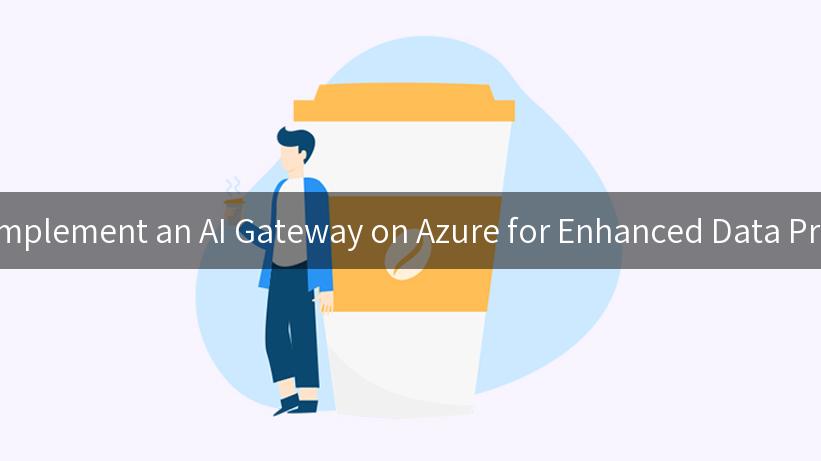
In today’s fast-paced digital world, businesses need to leverage advanced technologies to improve their operations, reduce costs, and enhance customer satisfaction. One way to achieve these goals is through the implementation of an AI gateway on a robust cloud platform like Azure. This article will guide you through the comprehensive steps to implement an AI gateway using Azure, focusing particularly on API calls, integration with tools like Traefik, and how to build an open platform for seamless data processing.
Understanding AI Gateways
Before diving into the implementation steps, let’s clarify what an AI gateway is. An AI gateway operates as a centralized interface that facilitates communication between various services, applications, and external systems. By integrating AI capabilities, such as Natural Language Processing (NLP) and machine learning, businesses can automate workflows and enhance data processing significantly.
Benefits of an AI Gateway
- Centralized Communication: All API calls routed through the gateway simplify management and enhance debugging.
- Enhanced Security: APIs can be secured, monitored, and logged through the gateway.
- Scalability: Leveraging a cloud platform, the AI gateway can automatically scale resources based on demand.
- Integration with External Services: Easily connect with various AI services available on Azure or third-party platforms.
Key Components for the Implementation
When implementing an AI gateway on Azure, there are several key components to consider:
- Azure API Management: Acts as your gateway for managing APIs.
- Azure Functions: Serverless compute service for executing code in response to HTTP requests.
- Traefik: An open-source HTTP reverse proxy and load balancer that makes deploying microservices easy.
- AI Services: Integrate Azure Cognitive Services for AI capabilities such as computer vision, speech recognition, and text analytics.
Overview of the Implementation Process
Here’s a high-level overview of the steps involved in implementing an AI gateway on Azure:
- Deploy Azure Resources: Set up the necessary Azure services such as API Management and Functions.
- Configure Traefik: Use Traefik to route traffic to your backend services.
- API Development: Create the APIs that will communicate with AI services.
- Integrate AI Solutions: Use Azure Cognitive Services for various AI functionalities.
- Testing and Validation: Ensure the gateway functions as expected through thorough testing.
- Deployment: Deploy the AI gateway for production use.
| Step | Description |
|-------------------------|----------------------------------------------------------|
| Deploy Azure Resources | Set up services needed for API management and functions. |
| Configure Traefik | Manage routing to backend services. |
| API Development | Create APIs for AI service interaction. |
| Integrate AI Solutions | Leverage Azure Cognitive Services for AI capabilities. |
| Testing and Validation | Verify that the gateway functions correctly. |
| Deployment | Launch the AI gateway for public use. |
Step-by-Step Guide to Implementing the AI Gateway
Step 1: Deploy Azure Resources
Begin by deploying the necessary Azure resources:
- Create an API Management instance:
- Navigate to the Azure portal.
- Select “Create a resource” > “API Management”.
-
Choose a suitable pricing tier based on your expected usage.
-
Set up Azure Functions:
- In the Azure portal, go to “Create a resource” > “Function App”.
- Configure the app settings such as the runtime stack and region.
Step 2: Configure Traefik
To configure Traefik, follow these steps:
-
Install Traefik using Docker:
bash
docker run -d -p 80:80 -p 443:443 traefik:v2.0 \
--api.insecure=true \
--providers.docker
-
Define Traefik’s dynamic configuration to manage routing:
- Create a
docker-compose.yml file to set up your services.
version: '3.8'
services:
api:
image: myapi:latest
labels:
- "traefik.enable=true"
- "traefik.http.routers.api.rule=PathPrefix(`/api`)"
- "traefik.http.services.api.loadbalancer.servers.port=80"
traefik:
image: traefik:v2.0
command:
- "--api.insecure=true"
- "--providers.docker=true"
ports:
- "80:80"
- "443:443"
Step 3: API Development
Once your environment is set up, proceed with API development:
- Create RESTful APIs using Azure Functions that will serve as microservices.
- Ensure REST APIs follow best practices, including proper use of HTTP methods and response codes.
Step 4: Integrate AI Solutions
Integrate AI capabilities by utilizing Azure Cognitive Services:
- In the Azure portal, navigate to “Create a resource” > “Cognitive Services”.
- Choose the specific AI service, such as Text Analytics for language processing, and configure access keys.
Step 5: Testing and Validation
Before moving to deployment, conduct thorough testing:
- Unit Tests: Test individual APIs for expected responses and performance metrics.
- Integration Tests: Ensure that APIs work correctly when integrated with various components and AI services.
Step 6: Deployment
Finally, deploy the AI gateway:
- Use Azure DevOps or GitHub Actions to automate your deployment pipeline.
- Monitor performance with Azure Monitor to ensure everything is running smoothly.
Conclusion
Implementing an AI gateway on Azure can significantly enhance data processing capabilities, enrich customer interactions, and improve operational efficiency. By leveraging Azure’s cloud resources, API management, and AI services, organizations can create powerful applications that drive success in the digital landscape.
Keywords Summary: in this guide, we explored the intricacies of API calls, træfik, Open Platform, and we have included a Diagram representing the workflow of integrating an AI Gateway on Azure.
“
APIPark is a high-performance AI gateway that allows you to securely access the most comprehensive LLM APIs globally on the APIPark platform, including OpenAI, Anthropic, Mistral, Llama2, Google Gemini, and more.Try APIPark now! 👇👇👇
“
Through these steps, your organization can harness the benefits of modern AI applications, streamlining workflows and positioning itself as an industry leader in the technological landscape. The flexibility and scalability offered by Azure’s cloud solutions ensure that your AI gateway can evolve with the growing needs of your business.
As you navigate through this implementation, consider the unique needs of your organization, and adjust the configurations accordingly to ensure optimal performance and security.